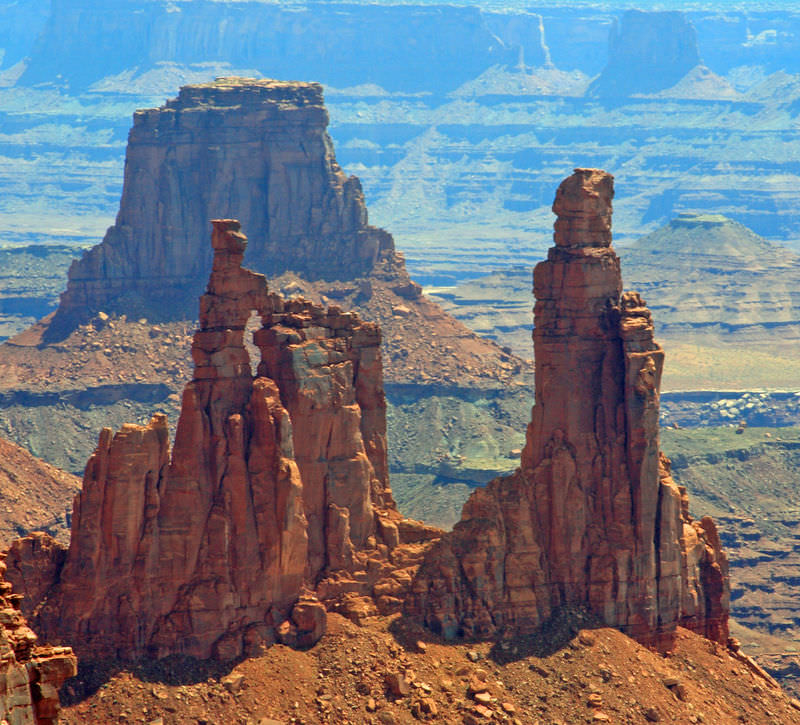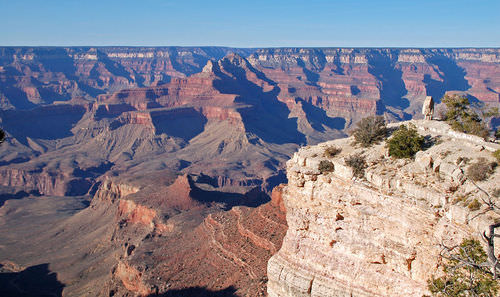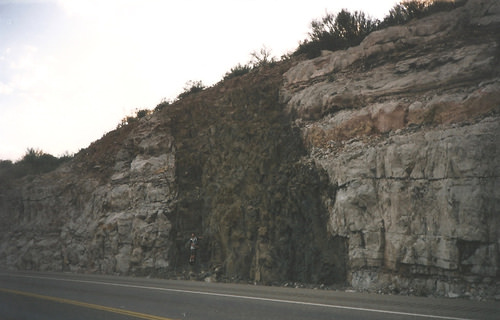15.4相对年代测定原则
章节大纲
-
Where's a good place to see stratigraphic layers?
::哪里是看地表层的好地方?The Southwestern United States is a fantastic place to see layered formations. The arid climate means that the rocks are not covered by vegetation. In many places, especially the national parks, the formations are fantastic. The rocks themselves are very interesting. The Southwest is a great place to study stratigraphy!
::美国西南地区是观察多层结构的绝佳地方。 干旱的气候意味着岩石没有植被覆盖。 在许多地方,特别是国家公园,岩层是奇妙的。 岩石本身非常有趣。 西南地区是研究地层学的好地方。Relative Age Dating
::相对年龄Early geologists had no way to determine the absolute age of a geological material. Without the technology of radioactive dating, they couldn't know if a rock was one million years or 100 million years old. What they could do was determine the ages of materials relative to each other. Using logical principles, they could say whether one rock was older than another. They could also determine when a process occurred relative to the formation of those rocks.
::早期的地质学家无法确定地质材料的绝对年龄。 没有放射性约会技术, 他们无法知道岩石是一百万年还是一亿年。 他们所能做的是决定材料的相对年龄。 他们可以用逻辑原理来判断一个岩石是否比另一个岩石老。 他们也可以确定这些岩石形成的过程是何时发生的。Laws of Stratigraphy
::地层法法The study of rock strata is called stratigraphy . The laws of stratigraphy can help scientists understand Earth’s past. The laws of stratigraphy are usually credited to a geologist from Denmark named Nicolas Steno. He lived in the 1600s. The laws are illustrated in Figure , and include the law of original horizontality , the law of lateral continuity , and the law of superposition .
::岩石层研究被称为地层学。地层学法可以帮助科学家了解地球的过去。 地层学法通常由丹麦的一位地质学家尼古拉斯·斯泰诺(Nicolas Steno)负责。 他生活在1600年代。 法律在图中有所说明,包括原始横向法、横向连续性法和叠加法。(a) Original horizontality. (b) Lateral continuity. (c) Superposition. Law of Superposition
::超置定律Superposition refers to the position of rock layers and their relative ages ( Figure ). Relative age means age in comparison with other rocks, either younger or older. The relative ages of rocks are important for understanding Earth’s history. New rock layers are always deposited on top of existing rock layers. Therefore, deeper layers must be older than layers closer to the surface. This is the law of superposition.
::叠加位置指岩石层的位置及其相对年龄(图 ) 。 相对年龄是指与其他岩石相比的年龄,无论是年轻还是更老。 岩石的相对年龄对于理解地球历史很重要。 新的岩石层总是沉积在现有岩石层之上。 因此,深层必须比靠近表面的层要长。 这是叠加法则。Superposition. The rock layers at the bottom of this cliff are much older than those at the top. What force eroded the rocks and exposed the layers? Law of Lateral Continuity
::横向连续性法律Rock layers extend laterally, or out to the sides. They may cover very broad areas, especially if they formed at the bottom of ancient seas. Erosion may have worn away some of the rock, but layers on either side of eroded areas will still “match up.”
::岩石的层层横向延伸,或向两侧延伸。 它们可能覆盖很广的区域,特别是如果它们形成于古代海洋底部。 侵蚀可能使一些岩石破损,但被侵蚀地区两侧的层仍将“接合 ” 。The Grand Canyon ( Figure ) is a good example of lateral continuity. You can clearly see the same rock layers on opposite sides of the canyon. The matching rock layers were deposited at the same time, so they are the same age.
::大峡谷( Figure ) 是横向连续性的好例子。 您可以清楚地看到峡谷对面的岩石层。 相匹配的岩石层同时沉积, 所以它们同年老 。Lateral Continuity. Layers of the same rock type are found across canyons at the Grand Canyon. Law of Original Horizontality
::原始水平定律Sediments were deposited in ancient seas in horizontal, or flat, layers. If sedimentary rock layers are tilted, they must have moved after they were deposited.
::如果沉积岩层倾斜,沉积层必须在沉积后移动。Principle of Cross-Cutting Relationships
::相互关系原则Rock layers may have another rock cutting across them, like the dark igneous rock cutting through the lighter sedimentary layers pictured below ( Figure ). Which rock is older? To determine this, we use the principle of cross-cutting relationships . The cut rock layers are older than the rock that cuts across them.
::岩石层可能会有另一块岩石横穿它们,比如在下面(图示 ) 所描绘的较轻沉积层中穿透的深色有色岩石。 哪个岩石更老? 要确定这一点, 我们使用交叉关系的原则。 切碎的岩石层比横穿它们的岩石要老。Cross-cutting relationships in rock layers. The rock layers at the bottom are cut off by the rock layers that are higher up. Which layers are older and which are younger? Unconformities
::不符合同Geologists can learn a lot about Earth’s history by studying sedimentary rock layers. But in some places, there’s a gap in time when no rock layers are present. A gap in the sequence of rock layers is called an unconformity .
::地质学家可以通过研究沉积岩层来了解地球历史。 但在某些地方,当没有岩石层存在时,还存在时空差距。 岩石层序列中的缺口被称为不兼容。Look at the rock layers pictured below ( Figure ); they show a feature called Hutton’s unconformity. The unconformity was discovered by James Hutton in the 1700s. Hutton saw that the lower rock layers were much older than the upper layers. The sets of layers are also tilted at different angles, meaning that the older layers must have been moved before the younger ones were deposited There are no layers in between the ancient and recent layers. Hutton thought that the intermediate rock layers eroded away before the more recent rock layers were deposited.
::看看下面的岩石层(图层);它们显示了一个叫Hutton不符合同的特征。1700年代,James Hutton发现了不符合同的特征。 Hutton看到,低层岩石层比上层要老得多。 层层也以不同角度倾斜,也就是说,老层必须在更小层沉积之前移动。 古层和最近层之间没有层层。 Hutton认为,中层岩石层在更近的岩石层沉积之前就被侵蚀了。Hutton's discovery was a very important event in geology! Hutton determined that the rocks were deposited over time. Some were eroded away. Hutton knew that deposition and erosion are very slow. He realized that for both to occur would take an extremely long time. This made him realize that Earth must be much older than people thought. This was a really big discovery! It meant there was enough time for life to evolve gradually.
::Hutton的发现是地质学上一个非常重要的事件! Hutton确定岩石是随时间沉积的。 有些人被侵蚀了。 Hutton知道沉积和侵蚀是非常缓慢的。 他意识到两者都需要很长时间才能发生。 这让他意识到地球必须比人们想象的要老得多。 这是一个非常巨大的发现。 这意味着有足够的时间让生命逐渐演变。Hutton's unconformity, in Scotland. Summary
::摘要- Sediments are deposited horizontally. This is original horizontality.
::沉积物水平沉积。 这是原始水平 。
- The oldest sedimentary rocks are at the bottom of the sequence. This is the law of superposition.
::最古老的沉积岩在序列的底部 这是叠加法则
- Rock layers are laterally continuous. This is the law of lateral continuity.
::岩石层是横向连续的 这是横向连续法则
- Rock B cuts across rock A. Rock A must be older. This is the principle of cross-cutting relationships.
::岩石B横跨岩石A. 岩石A. A. 必须更老。这是交叉关系的原则。
- A gap in a rock sequence is an unconformity.
::岩石序列的缺口是不符合同的。
Review
::回顾- How do Steno's laws help geologists to decipher the geological history of a region?
::Steno的法律如何帮助地质学家破译一个区域的地质史?
- Why does the principle of lateral continuity work?
::为什么横向连续性原则起作用?
- How could you recognize the existence of an unconformity?
::你怎么能承认存在不符合同的情况?
Explore More
::探索更多Use the resource below to answer the questions that follow.
::利用以下资源回答以下问题。- What is superposition?
::什么是叠加?
- How can the age of the layers be determined?
::如何确定层层的年龄?
- How does volcanic ash help scientists to determine the age of a rock sequence?
::火山灰如何帮助科学家 确定岩石序列的年代?
- What are the radioactive elements?
::什么是放射性元素?
- If a radiometric age can be determined is there any use for a relative age? Why or why not?
::如果能够确定辐射测定年龄,对于相对年龄是否有任何用途?为什么或为什么没有?
- Sediments are deposited horizontally. This is original horizontality.





